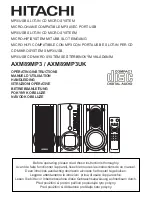
311
XL8 Control Centre
Operator Manual
Glossary
This section provides an explanation of some of the symbols, terms and abbreviations used in this
manual.
µ:
Micro- prefix symbol that represents 10
-6
or
one millionth.
A/D:
Abbreviation for “analogue to digital”. The
conversion of a continuous signal into a numeric
discrete sample sequence.
AES3:
Also known as “AES/EBU”, this is a serial
interface for transferring digital audio between
devices.
AES50:
AES digital audio engineering standard.
AES50 is a high resolution, multi-channel audio
interconnection (HRMAI). Rather than a
network, it is a high-performance, point-to-point
audio interconnection, although the auxiliary
data may operate as a true network,
independently of the audio. HRMAI provides a
professional multi-channel audio interconnection
that uses Cat5 data cable and is compatible with
Ethernet networks.
AES/EBU:
Abbreviation for “Audio Engineering
Society/European Broadcasting Union”; see
AES3
.
AFL:
Abbreviation for “after fader listen”.
amp (A):
Unit of current; short for “ampere”.
Area A:
Primary input control area.
Area B:
A secondary input control area.
Assignable controls:
Any controls, such as
select buttons (LCD switches), that can be set
up by the user to control any function required.
Auto safe:
Prevents channel from accepting
scene recall.
Auto-mute:
A function that automatically
mutes the channel’s signal under certain
conditions.
Auto-mute group:
A function that
automatically mutes a number of selected
channels under certain conditions.
Automation:
1. Memorization and playback of
changes made to mixer settings. 2. An area on
the output bay that controls these.
Aux:
Abbreviation for “auxiliary send” or “aux
send”. A designation for extra buses, typically
used for sending signal to effects, headphone
amps and other destinations. See
Bus
.
Aux send:
See
Aux
.
Balanced:
A type of audio connection that uses
the three leads in a cable, connector and jack as
part of a phase-cancelling arrangement to boost
the signal and reduce noise.
Band:
In EQ, a range of frequencies.
Bandwidth:
In EQ, the width of a band, that is,
the number of frequencies that will be
boosted/cut above and below a centre
frequency.
Bank:
A fixed number of channels displayed on
a GUI screen.
Bass:
Lower frequencies in a signal.
Bay:
One of the five main control centre
sections, which contains a control surface and a
GUI screen.
Bus:
A pathway down which one or more signals
can travel. A bus can be aux, sub, main,
master, mix or solo.
Channel:
Single path taken by an audio signal
(input or output) through the control centre.
Channel select button:
LCD button in the
input and output fast strips for channel
selection. The backlight colour and displayed
text are user-configurable for easy
identification.
Channel strip:
Row of controls in traditional
analogue layout used for the shaping of a signal.
CMR:
Abbreviation for “common mode
rejection”. A measure of how well a differential
amplifier rejects a signal that appears
simultaneously and in-phase at both input
terminals. CMR is usually stated as a dB ratio at
a given frequency.
Comb filtering:
Removal of signal components
at a number of regularly spaced frequencies.
Compressor:
A dynamics processor that
reduces the level of any signal exceeding a
specified threshold volume.
Condenser microphone:
A high quality mic
that uses a capacitor to detect changes in the
ambient air pressure, which it then converts into
Summary of Contents for XL8
Page 1: ...Operator Manual XL8 Control Centre...
Page 2: ......
Page 4: ......
Page 6: ......
Page 8: ......
Page 32: ...8 Chapter 1 Introduction XL8 Control Centre Operator Manual...
Page 50: ...26 Chapter 2 XL8 Live Performance System Overview XL8 Control Centre Operator Manual...
Page 56: ...32 Chapter 3 XL8 Control Centre Description XL8 Control Centre Operator Manual...
Page 79: ...Insert 55 XL8 Control Surface Operator Manual 1 2 3...
Page 111: ...Returns 87 XL8 Control Centre Operator Manual...
Page 121: ...Output bay GUI 97 XL8 Control Surface Operator Manual...
Page 124: ...100 Chapter 6 Output Bay XL8 Control Surface Operator Manual 1 2 3 4 5 6 7 8 9...
Page 128: ...104 Chapter 6 Output Bay XL8 Control Surface Operator Manual 1 2 3 4 5 6 7 8...
Page 168: ...144 Chapter 7 GUI Menu Options XL8 Control Centre Operator Manual...
Page 245: ...Audio signal path 221 XL8 Control Centre Operator Manual Audio signal path...
Page 255: ...Frequency chart 231 XL8 Control Centre Operator Manual Frequency chart...
Page 260: ...236 Chapter 11 Graphic Equaliser GEQ XL8 Control Centre Operator Manual...
Page 266: ...242 Chapter 12 Automation XL8 Control Centre Operator Manual...
Page 286: ...262 Chapter 13 Effects XL8 Control Surface Operator Manual...
Page 302: ...278 Chapter 16 Application Notes XL8 Control Centre Operator Manual...
Page 304: ...280 Appendix A Functional Block Diagrams XL8 Control Surface Operator Manual XL8 system buses...
Page 305: ...281 XL8 Control Surface Operator Manual XL8 system diagram...
Page 307: ...283 XL8 Control Surface Operator Manual Mono input channel signal flow...
Page 309: ...285 XL8 Control Surface Operator Manual Mono auxes and returns signal flow...
Page 311: ...287 XL8 Control Surface Operator Manual Mono group signal flow...
Page 313: ...289 XL8 Control Surface Operator Manual Master signal flow...
Page 315: ...291 XL8 Control Surface Operator Manual Stereo mix signal flow...
Page 317: ...293 XL8 Control Surface Operator Manual Comms signal flow...








































